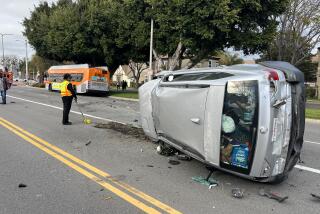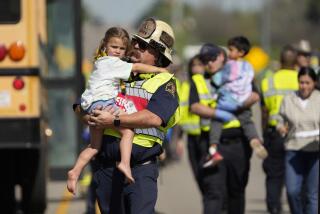Teen’s death aboard party bus focuses attention on a booming industry
Amy Zisette is still trying to piece together what happened that warm July night. There was music. Dancing. And unspeakable tragedy.
She does know that had she had been driving down the 405 Freeway and seen a bunch of teenagers standing up on an open-air, double-decker bus — so high they had to duck for overpasses — she would have done something.
“I would have panicked, just as a mother. I would have called 911 and had that bus pulled over,” Zisette said recently. “They were all good kids up there. It could have been any of them.”
But it was hers.
Mason Zisette was 16, a varsity tennis player looking forward to his junior year at Mira Costa High School. He was with a group of friends from Manhattan Beach, returning from a birthday celebration, when he hit his head on an overpass near Inglewood. He died two days later in a hospital, where scores of friends lined up to say goodbye before he was taken off life support.
“Our family is still trying really to understand,” Amy Zisette said. “I don’t want this to happen again.”
The number of party bus carriers nationwide has skyrocketed in the last five years — from 6,000 to 9,000 in California alone, records show — and more than 20 people have died in accidents. But most states have done little to regulate the industry, with efforts focusing mainly on alcohol use.
In Nebraska, passengers are allowed to drink on a party bus as long as the driver does not have access to alcohol. In New Jersey, passengers can drink, but the driver cannot provide the alcohol. And in Oklahoma, it is illegal for a hired bus or limousine service to knowingly transport minors in possession of alcohol.
One potential reform, safety experts and activists say, would be to address variations in how tall buses can be.
According to California Highway Patrol guidelines, buses normally cannot be more than 14 feet high. But in the case of double-decker buses, height restrictions are raised to just over 14 feet.
The overpass where Mason was struck has a vertical clearance of about 15 feet, 5 inches, according to Caltrans records.
His death marked the third high-profile party bus accident in Southern California in the last year.
Last September, a 24-year-old man was changing the music that was playing when he fell through a door onto the 101 Freeway, where he was struck by several vehicles near Universal City. The Los Angeles city attorney’s office this week filed criminal charges — related to safety issues — against the owner of the party bus, and the victim’s family is pursuing a wrongful-death claim.
In June, an Orange County high school student on her way to the prom was injured when she fell out of the window of a bus on the 73 Freeway near Santa Ana. Investigators determined the company was operating without a license.
Beyond California, two college students returning from a boating trip were killed in 2009 when they hit their heads on an overpass near Chicago. Lawsuits brought by the victims’ families alleged that there was drinking on the bus and that passengers on the top deck had never been told to stay seated. According to William Gibbs, an attorney who represented one of the families, the suits resulted in “substantial” settlements, although the amount has not been disclosed publicly.
And in 2012, a New Jersey teenager on a party bus bound for a Sweet 16 celebration was decapitated when he stuck his head out of the emergency hatch on the roof.
At least two states are becoming more aggressive in their attempts to address party buses.
In New York, a senator has proposed legislation that would legally define a party bus (something California law does not do), require a special driver’s license, mandate a chaperon for underage riders and install warning systems to alert the driver when a door or window has been opened.
And an investigation in Washington state last year after an 11-year-old girl fell from a window has resulted in a set of legislative recommendations there, including a provision prohibiting the use of double-decker party buses by private operators. The state regulatory commission’s report linked 21 deaths to party buses nationwide between 2009 and 2013 — the majority involving passengers falling from the vehicle. In four of the cases, which were tabulated before Mason’s death, passengers died after striking a highway overpass.
In California, a law went into effect last year that holds drivers, companies and adult chaperons responsible for ensuring that underage drinking does not occur on party buses.
Authorities have said that only non-alcoholic beverages were served on the bus carrying Mason. But the author of the California legislation said the accident on the 405 calls for a fresh look at whether more rules are needed.
“I think something has to be done to prevent this from occurring in the future, and I think there are reasonable possibilities,” said state Sen. Jerry Hill (D-San Mateo).
Among them, altering bus height restrictions.
Gage Stroman, a classmate of Mason’s who was on the bus that night, said passengers had come close to other overpasses during the trip.
“It just happened so fast,” Gage said of the accident. “We stood back up and heard a scream.”
Matt Zisette, Mason’s father, said it makes no sense for open-air, double-decker buses to be permitted on California freeways.
“It’s insane,” he said. “What happened to us, we would never wish on anyone. Something needs to be done.”
Twitter: @ScottGoldLAT, @mtthnsn, @caitlin_owens
More to Read
Start your day right
Sign up for Essential California for news, features and recommendations from the L.A. Times and beyond in your inbox six days a week.
You may occasionally receive promotional content from the Los Angeles Times.







